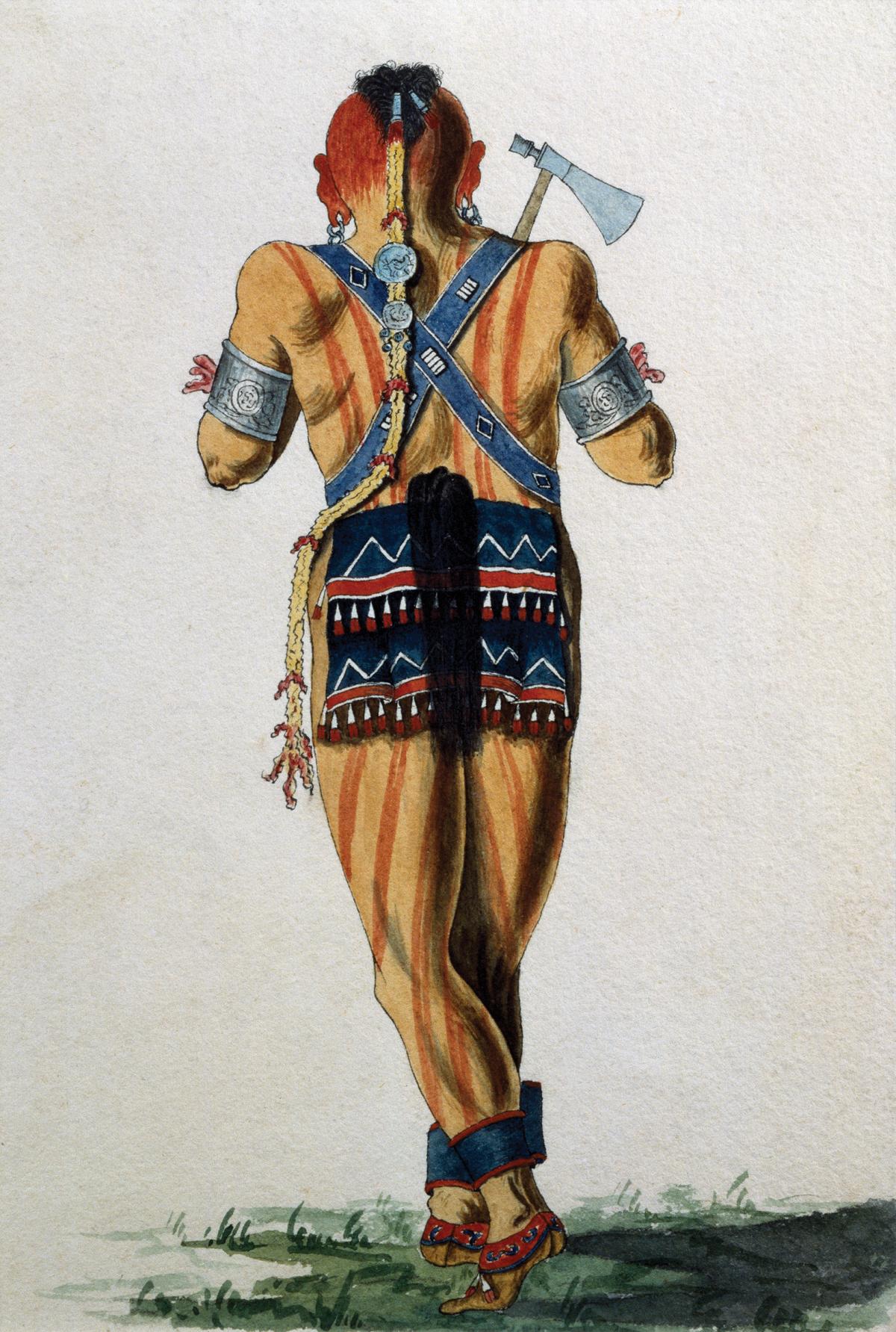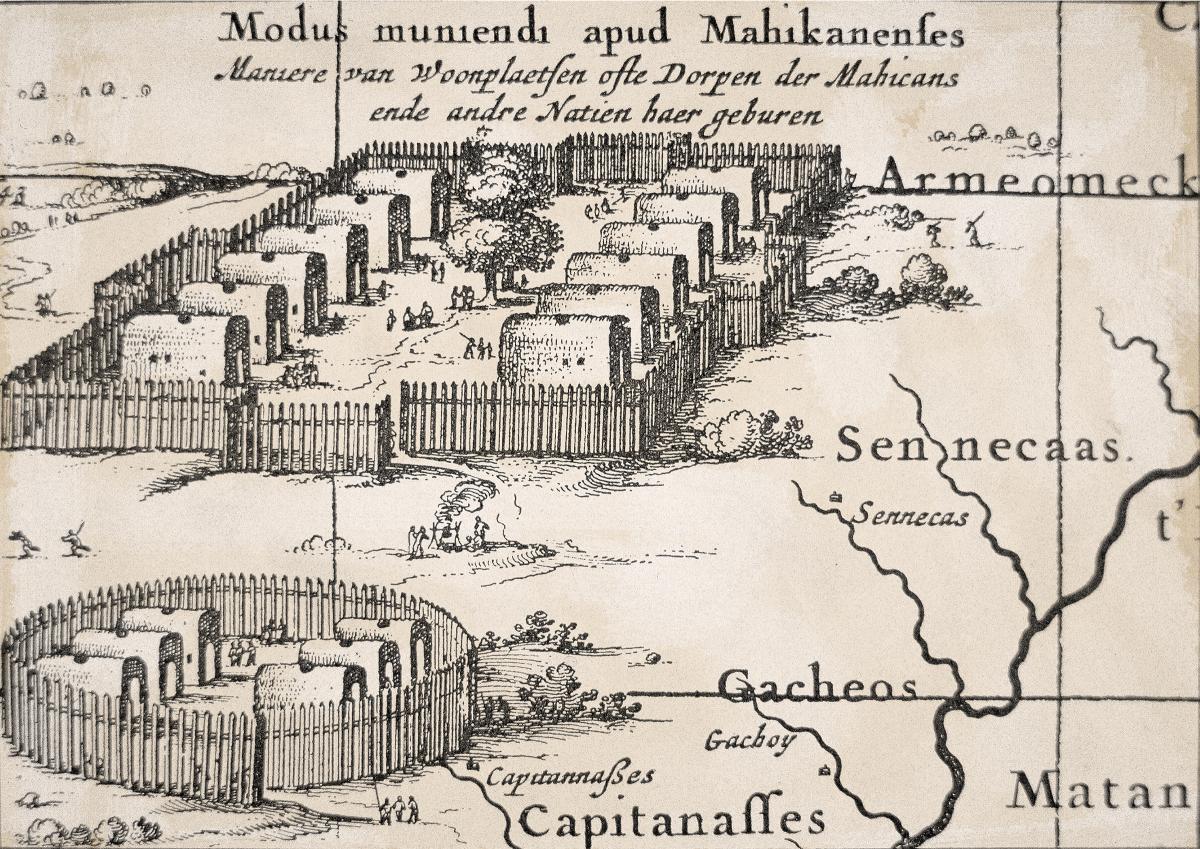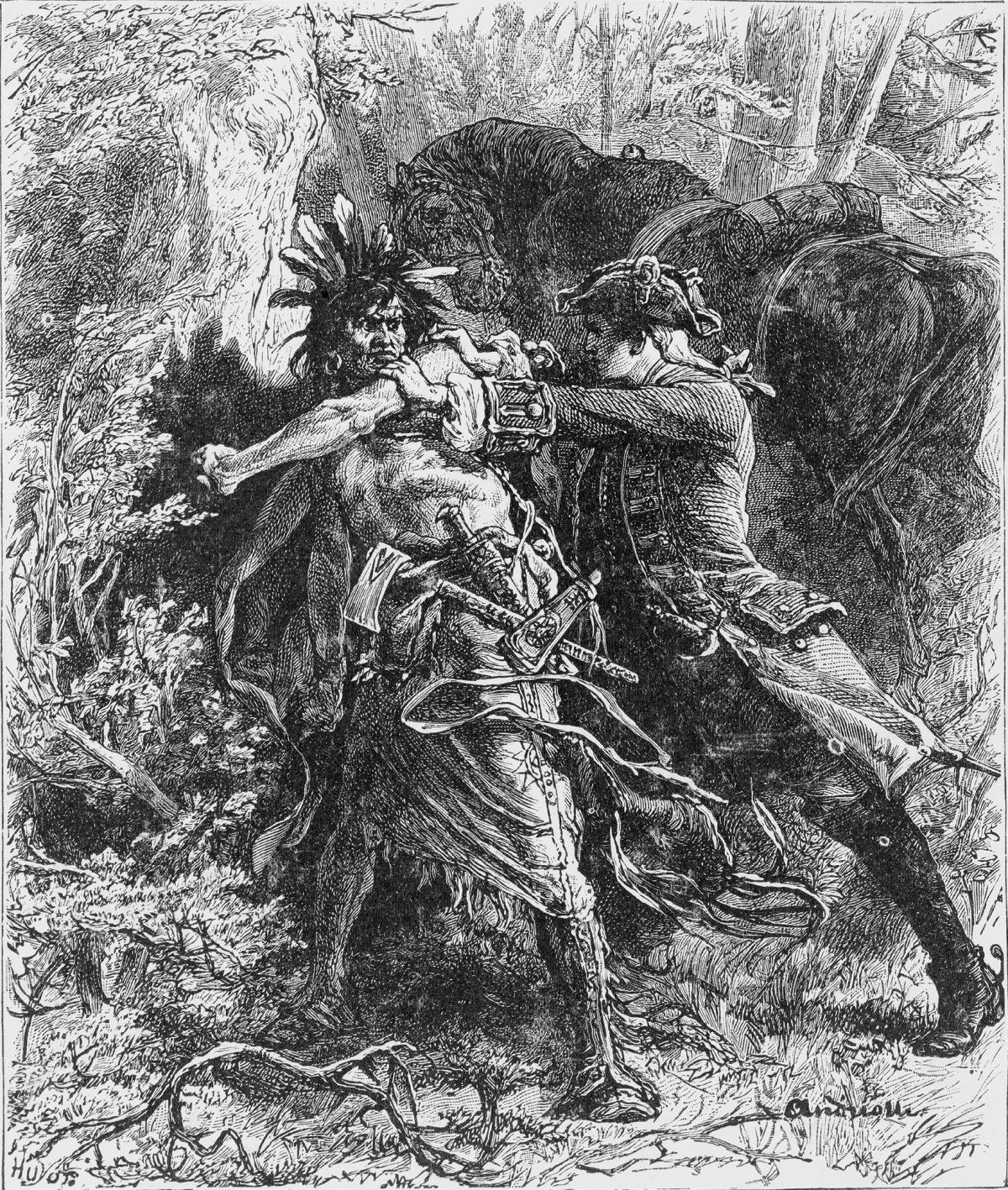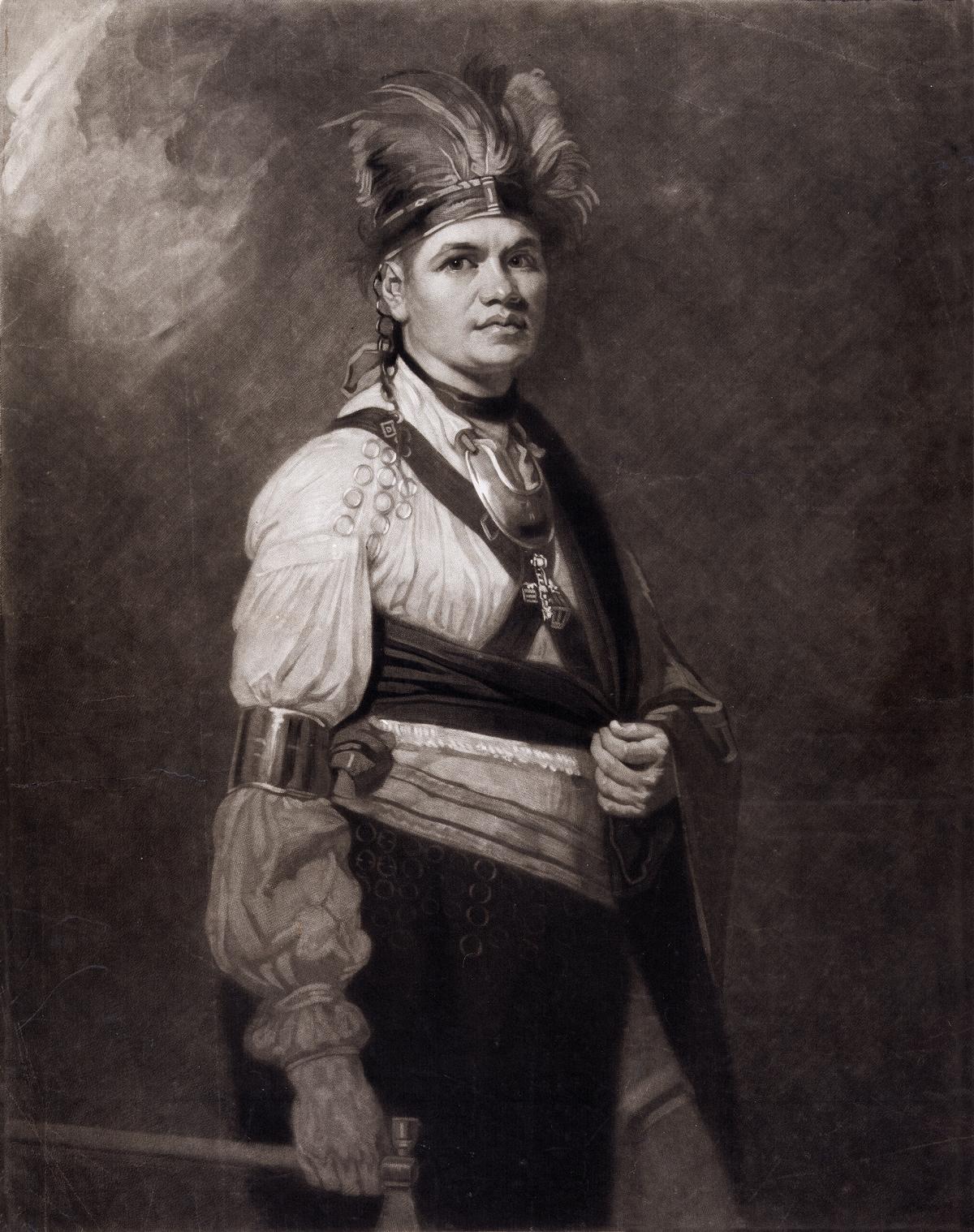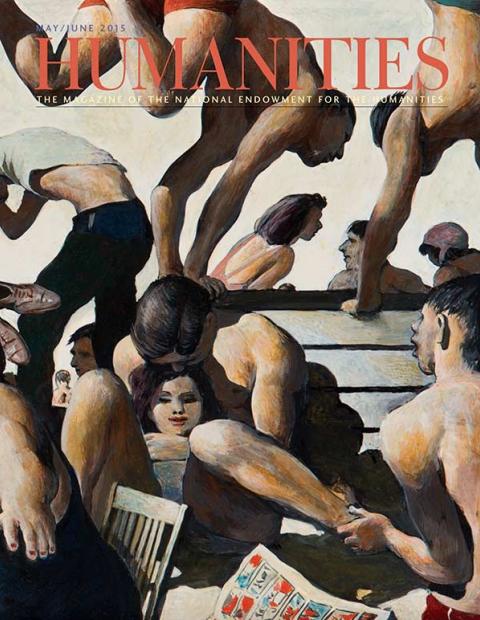Soldiers called her many things: “a very old Squaw,” “helpless impotent wretch,” “antediluvian hag.” Only one recorded anything like a name: “Madam Sacho.” Yet we would not even know that much about her if, in September 1779, Major General John Sullivan and his men had not stumbled across her in the desolate country of the Haudenosaunee (who have also been called many things, including Iroquois or the Six Nations).
The land, though very recently bustling with Indians, was eerily abandoned. Kettles had been left in a hurry by the hearth, books had been thrown aside, and tall corn stalks stood untouched, ready for harvest, in the field. Those who had evacuated perhaps imagined they would be returning to their homes soon. It was not to be. Sullivan and his men burned houses, fields, and whole towns down to the ground.
Madam Sacho must have emerged from the smoke like a ghost: startling, uncanny, and with a tale to tell. It was about war, conflict, and flight. There were many such narratives from the American Revolution. For the soldiers at the time and for modern audiences, though, Madam Sacho is a surprise. Soldiers expected whooping warriors with tomahawks raised. Some modern readers probably imagine the same, or else they envision tidy lines of redcoats firing against minutemen. But Sullivan’s Campaign was no Lexington and Concord, nor was it Yorktown. It was another kind of battle, with fewer casualties and yet profoundly destructive all the same.
It may seem an obscure, if arresting, episode: one little old lady against an entire set of regiments. Nevertheless, it reveals the small, usually overlooked, heroics of an ordinary woman caught in devastation, as well as something about one of the most important political players in early America, the Haudenosaunee. It also tells us something about the circumstances in which U.S. policy toward Native Americans was forged. Finally, itilluminates the agonizing decisions of that most famous American Revolutionary soldier of all: General George Washington.
Before turning to him, it helps to understand a few things about the Haudenosaunee and the background for Sullivan’s Campaign. The original five nations of the Haudenosaunee were Mohawk, Seneca, Cayuga, Onondaga, and Oneida. (The Tuscarora joined in the eighteenth century.) They had long been united diplomatically, centered in lands in what is now upstate New York. The Haudenosaunee were also called the Great League of Peace and Power. They were indeed powerful, but not entirely peaceful. They fought hard against many enemies, including Algonquins and others in the seventeenth century. Their matrons played an important role in deciding on war and peace, captivity and death. Women in these communities had long had the power to help select chiefs, to participate in councils, and to wage war. They were also central to the agricultural labor that provided resources, stability, and power. Indeed, one French observer declared that “it is the women who really make up the Nation. . . . All the real authority rests in the women.”
Haudenosaunee people generally lived in longhouses, which included an extended corridor dotted by hearths.As we know from eyewitness accounts and archaeological findings, those who shared the house and its hearths were kin, connected by marriage and blood. Compartments holding a nuclear family formed the sections of the house. Reciprocity and harmony were central ideals for those who lived together in these close quarters. Such values formed the basis for Haudenosaunee life and politics. Indeed, the word “Haudenosaunee” means “the whole house,” or, as historian Daniel Richter has framed it, “metaphorically, the five national fires of the Five Nations [later Six] stretched across Iroquoia like the central hearths of a communal dwelling, and reciprocity united their peoples.”
The Haudenosaunee initially followed a policy of neutrality in the American Revolution. Most of the confederacy, long allied with the British, had little interest in joining in the Patriot cause. Indeed, some leaders worked to get their people to actively join the British. One of the best known of these campaigners is Konwatsitsiaienni or Molly Brant, recognized in Mohawk communities as the widow of Sir William Johnson, the pre-Revolutionary British agent to the Indians. Her arguments were critical in drumming up support for the British, since “one word from her goes farther with them than a thous[an]d. from any White Man,” as one observer had it. Thanks to the efforts of her, her brother, and others, Mohawks and others began fighting on the side of the British. When the fateful resolution to join the British side passed the council of warriors, records noted that “the mothers also consent,” indicating the political standing of Haudenosaunee matrons. All but the Oneida and the Tuscarora joined (although the Onondaga split).
A series of raids by joint Haudenosaunee and British leadership on the borderlands of New York and Pennsylvania plagued Patriots in 1778. Among the most notorious were raids at Wyoming Valley and Cherry Valley. Haundenosaunee warriors struck at settlements, killing not only men but also women and children, in retaliation, as they saw it, for the ill treatment of their own families. One Patriot captain recalled: “Such a shocking sight my eyes never held before of savage and brutal barbarity; to see the husband mourning over his dead wife and four dead children lying by her side, mangled, scalpt.” Even Loyalist troops condemned “such acts of wanton cruelty committed by bloodthirsty savages as humanity would shudder to mention.” By 1779, the majority of the Haudenosaunee League, then, was proving deeply troubling to Patriot leaders, most notably, General George Washington, as well as another commander, Philip Schuyler. Washington declared: “The cries of the distressed, of the fatherless and the Widows, come to me from all quarters [and] appeared to leave me no alternative.”
Both Washington and Schuyler had served on the side of the British in the Seven Years’ War. This global conflict, which ran from 1756 to 1763 in Europe, in fact started in 1754 in the American colonies, where British-American colonists called it the “French and Indian War.” It was the crucible in which men like Washington and Schuyler hammered out their thinking about how to fight Indians, a question that frustrated many colonial and British officials. After the Seven Years’ War, one anonymous author argued for more rigorous methods in dealing with these enemies since “Whatever Inroads We have hitherto made in the Indian Country, have amounted to little. . . . [T]he Indians have commonly saved their Families & their own Persons & their Arms.” The same writer contended that “We have no Means of making the Indians afraid of us, because having no Towns, nor hardly Possessions nor Effects they can always secure their Persons & Families.” This view was incorrect; the Haudenosaunee had towns, homes, and possessions. Nevertheless, for this author, the only way to bring powerful Indian warriors to heel was to use women and children as leverage. He outlined plans in which soldiers should move in small parties to “Destroy any Indian Villages they met with . . . & carry off the Women & Children—(which wou’d soon bring in their Husbands & Fathers).” He continued that in this case the Indians “wou’d be afraid to quit their Families . . . instead of going out in Parties to murder our People, they wou’d tremble for their own.”
When faced with increasing hostilities during the Revolution, generals Washington and Schuyler therefore determined on a campaign to make Indians “tremble.” Such a plan depended on tactical violence against Native American civilians, specifically women andchildren. When Washington agonized over how to “carry . . . the War into the Indian Country,” he asked for Schuyler’s guidance on numbers of troops and methods required. Schuyler suggested: “Should we be so fortunate as to take a considerable number of the women and children of the Indians I conceive that we should then have the means of preventing them hereafter from acting hostily against us.”
Washington gave his assent, hoping that their “attacks will distract and terrify the Indians.” He added, “It is also to be hoped in their confusion, they may neglect in some places to remove the old men women and Children and that these will fall into our hands.” Washington argued that either American troops would be able to defeat Indian warriors, or at the very least they would “distress . . . them as much as possible, by destroying their villages, and this year’s crop.” So, Washington gave Major-General John Sullivan explicit instructions for the 1779 campaign: “The immediate objects are the total distruction and devastation of their settlements and the capture of as many prisoners of every age and sex as possible.” Washington also ordered a scorched-earth policy: “parties should be detached to lay waste all the settlements around, with instructions to do it in the most effectual manner; that the country may not be merely overrun but destroyed.” He stressed the need to achieve “the total ruin of their settlements” since “Our future security will be . . . in the terror” they experienced.
So, under the command of Major General Sullivan, several regiments marched. Almost all the inhabitants fled before soldiers arrived, but the corn was ripening in the field. Under orders, troops plundered houses and burned homes, fields, and even orchards, including forty towns and 160,000 bushels of corn. To destroy the fields and orchards so carefully cultivated by Haudenosaunee women was to inflict a visceral blow on the people of the Six Nations, evidently only just emerging from two years of poor harvests; fruit trees take years to grow back. In the midst of this carefully orchestrated rampage in early September, soldiers stumbled across Madam Sacho.
Soldiers’ diaries recount the shock they felt on finding her, detailing how, through an Oneida interpreter, she conversed with General Sullivan himself. Some soldiers wanted to kill her immediately, but, as one soldier recorded, “the common dictates of humanity, a veneration for old age, and a regard for the female world of any age or denomination induced our General to spare her.” Sacho recounted to the general a tale in which there had been a Council in her village, during which, as one soldier recorded, “there was a great debate between their warriors, their squaws, and children. The squaws had a mind to stay at home with their children.” Other soldiers, including Sullivan, reported that the women wanted the men to stay and fight, but the warriors did not think they stood a chance against the American troops—true perhaps but a somewhat self-serving claim by American soldiers. Either way, there seems to have been a debate about whether to stay and fight, or to flee, and Haudenosaunee matrons were critical to this decision.
Sullivan evidently disregarded Washington’s orders to take hostages “of every age and sex.” Sullivan not only left Sacho alone but provided her with food and shelter. The diarists, and most subsequent historians, emphasized the gift of food Sullivan made her, when his own soldiers did not have much to eat. They do so even after recognizing that Sullivan and his men were destroying all of the food the Haudenosaunee had planted, cultivated, and saved. Contemporary and historical accounts assume Sacho’s helplessness and victimization, as well as Sullivan’s personal kindness. A few troops condemned their leader’s actions. One soldier, having already complained bitterly of “Hungry bellies and hard Duty,” observed caustically after the gift of food: “I suppose she will live in splendour.” Other soldiers lauded the gallantry of their leader: “General Sullivan gave her a considerable supply of flour and meat, for which, with tears in her savage eyes, she expressed a great deal of thanks.” Here the general was a protector, indeed a “good angel” of a powerless old woman, as another witness phrased it.
Such a meeting, and the gallantry of their commanding officer to this elderly woman, relieved some of the bad feelings generated by what the soldiers, mostly farmers in the normal run of life, felt on destroying what they could see were fruitful, well-cultivated farms. Numerous soldiers stressed the bounty and beauty of the towns and crops they were demolishing. In a typical entry, one lieutenant wrote that “Our Brigade Destroyed about 150 Acres of the best corn that Ever I saw (some of the Stalks grew 16 feet high) besides great Quantities of Beans, Potatoes, Pumpkins, Cucumbers, Squashes & Watermellons.” One diarist recorded that Sacho’s town “contained nearly fifty houses, in general, very good. . . . We found several very fine corn-fields, which afforded the greatest plenty.” One soldier declared that “we destroy all their houses & fruit trees this afternoon which Seems to us a pity.” Another wrote home: “I really feel guilty as I applied the torch to huts that were Homes of Content until we ravagers came spreading desolation everywhere.”
Sacho appears to have exploited the uneasiness that men felt about their need to show kindness to women and children, even amid the terrible imperatives of war and the need to inflict suffering on an enemy. Still, the record of Sacho’s testimony tantalizes with other questions, ones not addressed in the detailed and well-sourced treatments of this campaign: Why was she left, and why did she tell this tale? It seems unlikely that, even if she were old and infirm, that her clan and kin, maybe even her children and grandchildren, would have just left a venerable matron behind to be killed by U.S. soldiers. As historian Daniel Richter has observed, these matrons, “the women of the lineage’s eldest living generation,” were “dominant figures morally, economically, and to some degree politically.” Also, why did she reveal this much detail about internal disagreements to what was without a doubt the enemy? Some historians have claimed she was threatened physically, but this point is not clear. It also seems somewhat unlikely.
The soldiers saw a “poor old creature,” reliant on Sullivan’s “humanity.” Most historians have followed suit. But what if we doubt these characterizations? It seems possible that she chose to stay, to sacrifice herself to plant and gather information, which may have helped her countrymen and women. After all, she “likewise told us that a great deal many Squaws & Children was over a hill somewhere near Seneca lake . . . in consequence of which . . . a Detachment of 3 or 400 Men” went in pursuit but returned without “seeing anything of them.” Maybe her story of the Council also served to emphasize that if women were captured, that they should be treated with “humanity,” too, because, after all, they had wanted peace and did not agree with the warriors.
Although soldiers emphasized Sacho’s lonely impotence, she was not alone. When the detachment returned a few weeks later, they found the body of a younger woman who had evidently been helping her. She had been shot, “supposed to be done by some of the soldiers.” The murder of this younger woman, a violation of that “regard for the female world,” which even several soldiers denounced as the actions of “some inhuman villain,” indicates the justified fears of the Haudenosaunee. An Onondaga chief later contended that when U.S. soldiers attacked his village, “they put to death all the Women and Children, excepting some of the Young Women, whom they carried away for the use of their Soldiers & were afterwards put to death in a more shamefull manner.” One scholar, Barbara Mann, has posited that this younger woman who had been with Madam Sacho may have been killed resisting rape. In any case, it suggests that she provoked lethal violence in a way the older woman did not.
The haunting trajectory of the murdered younger woman, whose name is lost, reminds us that violence against all kinds of women, settler and Indian, Patriot and Loyalist, occurred in this war. When the people of the Six Nations fled their homes, they cast aside books, including some volumes of the early eighteenth-century English periodical The Spectator. Did these include the volume, one wonders, in which the editors lamented that civil war “fills a Nation with Spleen and Rancour, and extinguishes all the Seeds of Good nature, Compassion and Humanity”? After all, the destruction of the orchards, crops, and homes of the Six Nations resonated long after the autumn of 1779. There was a terrible way in which the evacuation of Haudenosaunee from these lands, seemingly leaving only an old woman, allowed Americans to imagine a fuller “disappearance” all too easily. Indeed, even a preacher of a celebratory sermon at the conclusion of Sullivan’s campaign declared: “Led by the consideration of our just and complete conquest, of so fertile a part of the western world, I will venture to look a few years into futurity. . . . Methinks I see all these lands inhabited by the independent Citizens of America. I congratulate posterity on this addition of immense wealth and extensive territory to the United States.” Sacho, an old woman, became a symbol of the weakness of the actually quite powerful Confederacy of the Six Nations.
The image of the disappearing Indian is one that has filled many American narratives, as historian Jean O’Brien has argued. The land of the Six Nations was not in fact a ghost land, but as the Haudenosaunee had little to which to return, many did indeed flee to Fort Niagara. Rehearsing an American takeover of the land of the Six Nations, with the easily vanquished Sacho the only Indian left, allowed Anglo-Americans actually to take it over. Yet the people of this great League did not disappear. Modern Haudenosaunee people live on a range of reservations in the United States and Canada, as well as in many other places, and still have treaties with the U.S. Even in the face of systematic violence, the Haudenosaunee people survived. Narratives about both the violence, and the ability to resist it, can and should be part of our accounts of American history.
Soldiers patronizingly dismissed Sacho as “an old squaw.” Too often historians have accepted this kind of characterization. Yet this mother of her people still has power, if only we care to see it. Telling her story recasts other, older narratives. The image of George Washington simply as a compassionate father of the nation has already come under pressure since he was also a slave-holder, though one who freed his slaves in his will. His treatment of Indian women suggests other roles, as at least some contemporaries recognized. In 1790, a Seneca chief informed Washington: “When your army entered the country of the Six Nations, we called you Town Destroyer and to this day when your name is heard our women look behind them and turn pale, and our children cling close to the necks of their mothers.” Here were some of the painful costs of what participants called “this late unhappy war.” For some, the Founding Father was in fact a Town Destroyer. This is what wars, even “good” wars, do: They force dreadful choices on decent people and inflict suffering on innocent ones. Peering into the smoke rising from the longhouses of the Six Nations, we see one nation’s savage core. We also see the unexpected courage of those who withstood such horrors and endured.


